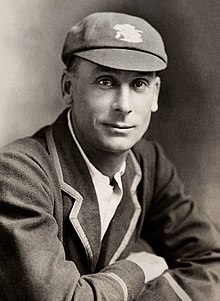
Back جاك هوبز Arabic جاك هوبز ARZ জ্যাক হবস Bengali/Bangla Jack Hobbs Czech Jack Hobbs (Cricketspieler) German Jack Hobbs (cricket) French जैक हॉब्स Hindi ジャック・ホッブス (クリケット選手) Japanese जैक हब्स MAI Jack Hobbs Malagasy
 Hobbs in about 1920 | ||||||||||||||||||||||||||||||||||||||||
| Personal information | ||||||||||||||||||||||||||||||||||||||||
|---|---|---|---|---|---|---|---|---|---|---|---|---|---|---|---|---|---|---|---|---|---|---|---|---|---|---|---|---|---|---|---|---|---|---|---|---|---|---|---|---|
| Full name | John Berry Hobbs | |||||||||||||||||||||||||||||||||||||||
| Born | 16 December 1882 Cambridge, England | |||||||||||||||||||||||||||||||||||||||
| Died | 21 December 1963 (aged 81) Hove, East Sussex, England | |||||||||||||||||||||||||||||||||||||||
| Nickname | The Master | |||||||||||||||||||||||||||||||||||||||
| Batting | Right-handed | |||||||||||||||||||||||||||||||||||||||
| Bowling | Right-arm medium | |||||||||||||||||||||||||||||||||||||||
| Role | Opening batsman | |||||||||||||||||||||||||||||||||||||||
| International information | ||||||||||||||||||||||||||||||||||||||||
| National side | ||||||||||||||||||||||||||||||||||||||||
| Test debut (cap 157) | 1 January 1908 v Australia | |||||||||||||||||||||||||||||||||||||||
| Last Test | 16 August 1930 v Australia | |||||||||||||||||||||||||||||||||||||||
| Domestic team information | ||||||||||||||||||||||||||||||||||||||||
| Years | Team | |||||||||||||||||||||||||||||||||||||||
| 1905–1934 | Surrey | |||||||||||||||||||||||||||||||||||||||
| Career statistics | ||||||||||||||||||||||||||||||||||||||||
| ||||||||||||||||||||||||||||||||||||||||
Source: ESPNcricinfo, 10 March 2017 | ||||||||||||||||||||||||||||||||||||||||
Sir John Berry Hobbs (16 December 1882 – 21 December 1963) was an English professional cricketer who played for Surrey from 1905 to 1934 and for England in 61 Test matches between 1908 and 1930. Known as "The Master", he is widely regarded as one of the greatest batsmen in the history of cricket. He is the leading run-scorer and century-maker in first-class cricket, with 61,760 runs and 199 centuries.[notes 1] A right-handed batsman and an occasional right-arm medium pace bowler, Hobbs also excelled as a fielder, particularly in the position of cover point. Hobbs was named as one of the five Wisden Cricketers of the Century alongside Sir Donald Bradman, Sir Garfield Sobers, Shane Warne, and Sir Viv Richards.
Born the eldest of 12 children to a Cambridge cricket groundsman and umpire in 1882, Hobbs wished from an early age to pursue a career in cricket from following his father's matches at Cambridge University colleges, and playing for teams on Parkers Piece.[2]
His early batting was undistinguished, but a sudden improvement in 1901 brought him to the attention of local teams. In 1903, he successfully applied to join Surrey, with the support of England batsman Tom Hayward. His reputation grew and when he qualified to play for Surrey, he scored 88 on his first-class debut and a century in his next game. Over the following seasons, he established himself as a successful county player and in 1908 made his Test debut for England, scoring 83 in his first innings. After some mixed early performances for England, Hobbs' success against South African googly bowlers made his place secure, and by 1911–12, when he scored three centuries in the Test series against Australia, critics judged him the world's best batsman. In county cricket, he developed an attacking, dynamic style of play and was very successful up until 1914. After serving in the Royal Flying Corps during the First World War, he maintained his reputation when cricket resumed in 1919, but his career was threatened by appendicitis, which caused him to miss most of the 1921 season. When he returned, he was a more cautious batsman and used a safer style of play. Subsequently, he became more consistent and scored prolifically in both Test and domestic cricket until his retirement. During this period, he played some of his most acclaimed innings.
Hobbs' success was based on fast footwork, an ability to play many different shots, and excellent placement of the ball. Among the first batsmen to succeed against previously devastating googly bowlers, he adapted his technique to meet the new styles of bowling that arose early in his career; he mixed classical shots with an effective defence. He was particularly successful on difficult pitches for batting. An opening batsman, Hobbs established several effective opening partnerships; with Tom Hayward and Andy Sandham for Surrey and with Wilfred Rhodes and Herbert Sutcliffe for England. Despite batting against "ruthless bowlers on very hostile pitches with [fewer] safety regulations", his partnership with Sutcliffe remains in 2022 the highest average for a first-wicket partnership in Test history by a wide margin.[3] Contemporaries rated Hobbs extremely highly, and critics continue to list him among the best batsmen of all time.
Hobbs was very close to Ada, his wife of 56 years; the pair were able to live comfortably in later life through Hobbs' substantial wage from Surrey, his commercial endorsements, and the proceeds of the sporting goods shop he opened in 1921 and ran for nearly the rest of his life.
After his cricketing retirement, he also worked in journalism. Knighted in 1953 — the first professional cricketer to be so honoured — he spent his later years nursing his wife. He died, aged 81, a few months after her in 1963.
- ^ "Most Runs in First-Class matches". Wisden. Retrieved 6 May 2013.
- ^ "Sir Jack Hobbs (1882 - 1963)". Cambridge Past, Present and Future. December 2010.
- ^ Hall, Nathan (3 January 2022). "Top ten Test opening pairs in history". The Roar. Archived from the original on 27 January 2022. Retrieved 27 January 2022.
Cite error: There are <ref group=notes> tags on this page, but the references will not show without a {{reflist|group=notes}} template (see the help page).
© MMXXIII Rich X Search. We shall prevail. All rights reserved. Rich X Search